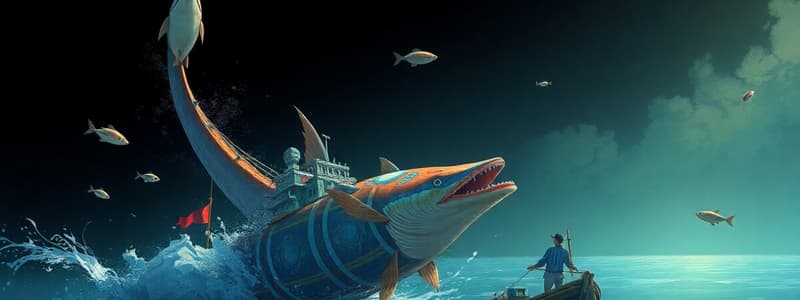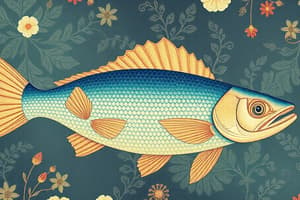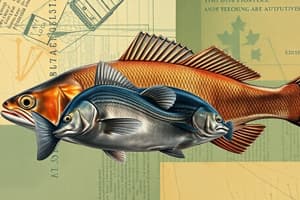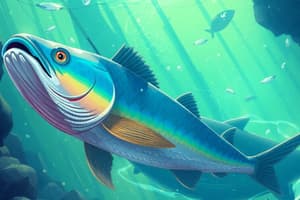Podcast
Questions and Answers
How does the United Nations Convention on the Law of the Sea (UNCLOS) impact the exercise of Philippine sovereignty over its internal waters?
How does the United Nations Convention on the Law of the Sea (UNCLOS) impact the exercise of Philippine sovereignty over its internal waters?
- It restricts Philippine sovereignty, requiring international consent for any activity.
- It allows the Philippines to disregard international treaties when exercising sovereignty.
- It mandates joint management of internal waters with neighboring countries.
- It grants the Philippines full sovereignty, including seabed and subsoil rights. (correct)
What distinguishes the "Archipelagic Doctrine" from typical maritime zone definitions in international law?
What distinguishes the "Archipelagic Doctrine" from typical maritime zone definitions in international law?
- It mandates the sharing of archipelagic waters for resource exploitation with neighboring states.
- It allows unrestricted passage for foreign vessels, superseding national laws.
- It considers the entire archipelago a single unit with internal waters, subject to exclusive sovereignty. (correct)
- It applies only to uninhabited islands, with exceptions for economic activities.
In what ways does the assertion of sovereign rights within the Exclusive Economic Zone (EEZ) by the Philippines differ from a claim of full sovereignty?
In what ways does the assertion of sovereign rights within the Exclusive Economic Zone (EEZ) by the Philippines differ from a claim of full sovereignty?
- The Philippines must share resource revenues with international organizations.
- The Philippines possesses surface but not subsurface rights, allowing unregulated international fishing.
- The Philippines can only explore and exploit resources while respecting international laws. (correct)
- The Philippines has exclusive authority over all activities, including navigation and overflight.
How did the United Nations Commission on the Limits of the Continental Shelf's (UNCLOS) decision regarding Benham Rise (Philippine Rise) affect Philippine maritime claims?
How did the United Nations Commission on the Limits of the Continental Shelf's (UNCLOS) decision regarding Benham Rise (Philippine Rise) affect Philippine maritime claims?
What restrictions apply to fishing vessels operating within High Seas Pocket No. 1 relative to High Seas Pocket No. 2?
What restrictions apply to fishing vessels operating within High Seas Pocket No. 1 relative to High Seas Pocket No. 2?
Under what conditions is it deemed illegal for a Philippine-flagged fishing vessel to operate in the territorial seas of another state?
Under what conditions is it deemed illegal for a Philippine-flagged fishing vessel to operate in the territorial seas of another state?
Which administrative action would directly support the national government's goal to increase aquaculture outputs?
Which administrative action would directly support the national government's goal to increase aquaculture outputs?
What measures might a coastal municipality take to balance ecological preservation with economic growth from its fishery resources?
What measures might a coastal municipality take to balance ecological preservation with economic growth from its fishery resources?
What factors explain why commercial fishing operations are required to operate beyond municipal waters in the Philippines?
What factors explain why commercial fishing operations are required to operate beyond municipal waters in the Philippines?
Why might the local government regulate municipal fishing activities?
Why might the local government regulate municipal fishing activities?
How are Integrated Fisheries and Aquatic Resources Management Councils (IFARMCs) intended to improve resource management?
How are Integrated Fisheries and Aquatic Resources Management Councils (IFARMCs) intended to improve resource management?
In a municipal fishing operation, how does the sharing system typically distribute the catch between the boat owner and the fishers?
In a municipal fishing operation, how does the sharing system typically distribute the catch between the boat owner and the fishers?
What are the primary requisites for fisherfolk organizations/cooperatives to be granted use of demarcated fishery areas?
What are the primary requisites for fisherfolk organizations/cooperatives to be granted use of demarcated fishery areas?
Knowing that the trend shows a stable volume of production in aquaculture from 2013 to 2015. In 2022, aquaculture production increased by 102,936.24 MT or 4.58% from the previous year. How can aquaculture value of production continue even if volume decreased?
Knowing that the trend shows a stable volume of production in aquaculture from 2013 to 2015. In 2022, aquaculture production increased by 102,936.24 MT or 4.58% from the previous year. How can aquaculture value of production continue even if volume decreased?
What does the term "technical measures" refer to in the context of fisheries management?
What does the term "technical measures" refer to in the context of fisheries management?
Which of the following factors must be considered when introducing gear restrictions in fisheries?
Which of the following factors must be considered when introducing gear restrictions in fisheries?
Why is standardization vital for sustainability when utilizing aquaculture??
Why is standardization vital for sustainability when utilizing aquaculture??
What outcome is most likely when regulations are put in place without assessing bycatch?
What outcome is most likely when regulations are put in place without assessing bycatch?
What is the principal aim that prompts the enforcement of mesh size regulations?
What is the principal aim that prompts the enforcement of mesh size regulations?
Which of the following considerations represents the most significant challenge in optimizing mesh size for a multi-species fishery?
Which of the following considerations represents the most significant challenge in optimizing mesh size for a multi-species fishery?
In what ways do 'command-and-control' measures differ from technology standards in managing bycatch?
In what ways do 'command-and-control' measures differ from technology standards in managing bycatch?
What is the primary effect that would be most expected from enforcing the installation of juvenile and trash fish excluder devices (JTED) in trawls?
What is the primary effect that would be most expected from enforcing the installation of juvenile and trash fish excluder devices (JTED) in trawls?
How does the prohibition of specific fishing gears contribute to promoting sustainable practices?
How does the prohibition of specific fishing gears contribute to promoting sustainable practices?
In the structure of a commercial fishing operation run with work distribution of FAD-fishers, which role requires expertise in estimating fish biomass?
In the structure of a commercial fishing operation run with work distribution of FAD-fishers, which role requires expertise in estimating fish biomass?
Flashcards
What are fisheries?
What are fisheries?
Activities related to fishing, culturing, preserving, processing, marketing, developing, conserving and managing aquatic resources.
Fishing
Fishing
Taking of fishery species with or without gears or vessels.
Fisher
Fisher
A person who catches fish/fishery resources.
Fishing Gear
Fishing Gear
Signup and view all the flashcards
Fishing Paraphernalia
Fishing Paraphernalia
Signup and view all the flashcards
Fishing Method
Fishing Method
Signup and view all the flashcards
Fishing Ground
Fishing Ground
Signup and view all the flashcards
Fishing Vessel
Fishing Vessel
Signup and view all the flashcards
Internal Waters (Philippines)
Internal Waters (Philippines)
Signup and view all the flashcards
Archipelagic Waters
Archipelagic Waters
Signup and view all the flashcards
Territorial Sea (Philippines)
Territorial Sea (Philippines)
Signup and view all the flashcards
Contiguous Zone (Philippines)
Contiguous Zone (Philippines)
Signup and view all the flashcards
Exclusive Economic Zone (EEZ)
Exclusive Economic Zone (EEZ)
Signup and view all the flashcards
Continental Shelf (Philippines)
Continental Shelf (Philippines)
Signup and view all the flashcards
Benham Rise (Philippine Rise)
Benham Rise (Philippine Rise)
Signup and view all the flashcards
High Seas
High Seas
Signup and view all the flashcards
Aquaculture
Aquaculture
Signup and view all the flashcards
Municipal Marine Fisheries
Municipal Marine Fisheries
Signup and view all the flashcards
Commercial Marine Fisheries
Commercial Marine Fisheries
Signup and view all the flashcards
Sea
Sea
Signup and view all the flashcards
Bay
Bay
Signup and view all the flashcards
Gulf
Gulf
Signup and view all the flashcards
Channel
Channel
Signup and view all the flashcards
Strait
Strait
Signup and view all the flashcards
Lake
Lake
Signup and view all the flashcards
Study Notes
Part 1: Overview of Philippine Fisheries
- Fisheries relates to fishing, culturing, preserving, processing, marketing, developing, conserving and managing aquatic resources, including the privilege to fish (RA 8550).
- Applying scientific knowledge to fish populations. Optimizing the production of fishery products are key for factory material or angling.
Related Terms
- Fishing involves the extraction of fishery species from their natural habitat, with or without tools like gears or vessels.
- A fisher is someone who catches fish or fishery resources.
- Fishing gear includes instruments, devices, and accessories for catching fish.
- Fishing paraphernalia is the material used during fishing operations: safety gear, fish aggregating devices, fishing accessories, and boats.
- The fishing method is the operation of fishing gear or a specific technique employed.
- A fishing ground is an area in any body of water where fish and aquatic resources gather, making them targets for capture.
- A fishing vessel is any watercraft used for catching fish species or assisting other vessels in related activities, including preservation, supply, storage, refrigeration, and transportation.
Major Areas
- Aquatic Ecology and Resource Management.
- Capture Fisheries.
- Aquaculture.
- Post-Harvest Fisheries.
Fishery Resources
- The Philippines has 2,200,000 km² of territorial water, including a 266,000 km² coastal area and a 1,934,000 km² oceanic area.
- There are 36,289 km of coastline and a 184,600 km² shelf area.
- The country has 27,000 sq. km. of coral reefs.
- There are 3,212 fish species, with 731 being commercially important like 2,645 marine, 251 brackish water, and 348 freshwater species.
- Other species include 168 sharks and rays, 648 mollusks, and 28 marine mammals.
- The Philippines also has 5 marine turtles, 19 species of seagrasses, and 1,082 species of seaweeds
- There are also 46 species of mangroves and 550 corals, of which 500 are hard and 50 are soft.
- Around 2,000 species of reef fishes are in the Philippines.
Philippine Maritime Entitlements
- Internal Waters.
- Archipelagic Waters.
- Territorial Sea.
- Contiguous Zone.
- Exclusive Economic Zone (EEZ).
- Extended Continental Shelf (Philippine Rise).
Internal Waters
- Internal Waters refer to water on the landward side of archipelagic baselines (not part of Archipelagic Waters) and water on the landward side of the baseline of the territorial sea of territories outside archipelagic baselines.
- The Philippines exercises sovereignty over its Internal Waters and airspace, seabed, and subsoil according to treaties like the 1982 UNCLOS.
Archipelagic Waters
- Archipelagic Waters are waters on the landward side of archipelagic straight baselines, excluding internal waters
- The Archipelagic Doctrine treats an archipelago as a single unit, with waters around, between, and connecting islands forming part of internal waters, subject to exclusive sovereignty.
Territorial Sea
- The Philippines' Territorial Sea is the sea enclosing entirety of archipelago, measured 12 nautical miles from baselines.
- The Philippines exercises sovereignty over its territorial sea waters, airspace, seabed, and subsoil, as per UNCLOS and treaties.
Contiguous Zone
- The Contiguous Zone refers to waters beyond and adjacent to the territorial sea to the extent of 24 nautical miles from baselines, and the Philippines exercises sovereign rights in accordance with UNCLOS.
Exclusive Economic Zone
- The Exclusive Economic Zone (EEZ) refers to waters extending 200 nautical miles from baselines or low-water line, adjacent to the territorial sea.
- The Philippines exercises sovereign rights to explore and exploit resources in accordance with UNCLOS.
- Sovereign right means coastal state’s rights below sea surface.
Continental Shelf
- The Continental Shelf includes the seabed and subsoil extending beyond the territorial sea throughout the natural prolongation of the land territory, or 200 nautical miles from the baselines.
- The Philippines exercises sovereign rights over this area's resources in accordance with UNCLOS.
The Benham Rise (Philippine Rise)
- In 2012, the submission of the Philippines was approved regarding continental shelf limits in the Benham Rise region (renamed Philippine Rise).
- The Philippine Rise is a 24.4 million hectare undersea region east of Luzon, including a 13.4 million hectare outer section.
- A presidential proclamation protects 50,000 hectares of the Philippine Rise, particularly the Benham Bank with 100% coral cover, as a "strict protection zone".
High Seas
- The high seas extend beyond a state's exclusive economic zone.
- High Seas Pocket No. 1 is bound by the EEZs of Micronesia, Palau, Indonesia, and Papua New Guinea.
- High Seas Pocket No. 2 is bounded by the EEZs of the Cook Islands, French Polynesia, and Kiribati.
- High Seas Pockets 3 and 4 have been proposed by FFA to be closed to purse seine fishing.
- Mati-matihan is a High Seas Pocket adjacent to the East of the Philippines.
- The high seas are open to all states; however, fishing vessels in High Seas Pocket 1 (HSP-1 SMA) cannot fish in High Seas Pocket 2 (Eastern High Seas SMA).
Legal basis to fish in the high seas
- UNCLOS and the Fish Stocks Agreement (UNFSA) gives all states the right to fish the high seas subject to certain conditions.
- It’s unlawful to fish in the high seas, territorial seas, archipelagic waters, or EEZs of other states using a Philippine-flagged vessel without a fishing permit from the Department and authorization from the coastal state (RA 10654).
Philippines Major Fishing Grounds
- The Philippines has various major fishing grounds, including seas, bays, gulfs, channels, straits and passages.
Seas
- A sea is a significant body of saltwater that occupies a substantial portion of a territorial water.
Bays
- A bay is a coastal area, partially enclosed by land, that is abundant in fishery resources. Indentations are well-marked and contain landlocked waters.
Gulfs
- A gulf is larger than a bay, representing an arm of the sea or ocean surrounded by substantial landmasses.
Channels and passages
- A channel is waterway that passes between two land masses. Passages are also waterways, but are narrower.
Straits
- A strait is a narrow body of water that connects two larger water bodies.
Lakes
- A lake is an inland body of water, an expanded part of a river or a lake basin.
Seas
- East Sulu Sea is by ZamboangaDel Norte/Negros with 9,288 Sq. Km
- Sibuyan sea; Aklan/Masbate/Romblon with 8,127 Sq. Km
- Visayan sea; Cebu/Masbate/Panay Negros Occidental with 3,096 Sq. Km
- West Sulu Sea; Palawan with 29,993 Sq. Km
- South Sulu Sea Zamboanga del Sur/Sulu/Tawi-Tawi 112,642 Sq. Km
- Samar Sea; Samar/Masbate/ Leyte with 3,870 Sq. Km
- Camotes Sea; Cebu/Leyte/ Bohol with 2,477 Sq, Km
- Bohol sea; Bohol with 7,946 Sq. Km
Bays
- Manila Bay; Manila/Bataan/ Cavite with 1,935.00 sq. kilometers
- Tayabas Bay; Quezon Province with 2,213.00 sq. kilometers
- Imuruan Bay; Palawan with 1,087.80 sq. kilometers
- Lamon Bay; Camarines Norte/ Quezon with 2,838.00 sq. kilometers
- San Miguel Bay; Camarines Sur with 774.00 sq. kilometers
- Illana Bay; Lanao del Sur/Maguindanao with 2,128.50 sq. kilometers
- Butuan Bay: Agusan del Norte with 516.00 sq. kilometers
- Sibugay Bay: Zamboanga del Sur with 1,935 sq. kilometers
- Tawi-Tawi Bay: Tawi-Tawi with 592.40 sq. kilometers
Gulfs:
- Lingayen Gulf is in Pangasinan with 2,064 sq. kilometers
- Ragay Gulf; Camarines Sur and Quezon with 3,225 sq. kilometers
- Asid Gulf; Masbate with 619 sq. Kilometers
- Panay Gulf; Iloilo/Negros Occidental with 2,311 sq. kilometers
- Leyte Gulf; Leyte Island Samar Island with 2,724 sq. kilometers
- Albay Gulf; Albay with 413 sq. kilometers
- Lagonoy Gulf; Camarines Sur/ Catanduanes/Albay with 1,935 sq. kilometers
- Davao Gulf; Davao del Sur/ Davao del Norte Davao Oriental with 4,024 sq. kilometers
- Moro Gulf; Maguindanao/Sultan Kudarat/Zamboanga del Sur with 12,900sq. kilometers
Channels:
- Burias Pass; Burias Island/ Camarines Sur with 1,393.20 sq. kilometers
- Jintotolo Channel is in Capiz/ Masbate with 280 sq. kilometers
- Babuyan Channel; Babuyan Island/ Cagayan with 3,612 sq.kilometers
- Maqueda Channel; Camarines Sur/ Catanduanes with 129 sq. kilometers
- Ticao Pass; Ticao Island/ Sorsogon with 804.75 sq. kilometers
Straits:
- Iloilo Strait; Iloilo/Guimaras with 1,006.00 sq.kilometers
- Tablas Strait; Mindoro Oriental/ Tablas Island with 1,935sq.km.
- Cebu Strait, Cebu /Bohol with 1,818.90sq.km
- Mindoro Strait ;Mindoro Occidental/ Palawan with 3,426.20sq.km
- Tanon Strait; Cebu/Negros with 2,786.40sq.km
Major lakes Locations
- Locations are as follows
- Laguna de Bay- Laguna, Area- 88,055.24 ha
- Taal Lake -Batangas Area- 22,918.76 ha
- Naujan Lake- Oriental Mindoro Area- 7,576.32 ha
- Lake Mainit- Agusan del Norte, Surigao del Norte -14,202 ha
- Bato Lake- Camarines Sur, Albay, Area: 2,617.81 ha
- Lake Bueno -Lake Wood Lake Banao -Location: Lanao del Sur
Capture Fisheries Sub-Sectors
- Municipal marine fisheries operate within municipal waters (15 km from the coastline) using fishing vessels of 3 gross tons or less, or when no fishing vessel is used.
- Commercial marine fisheries operate beyond municipal waters using fishing vessels of more than 3 gross tons.
- Small-scale is 3.1 GT - 20 GT.
- Medium-scale is 20.1 GT - 150 GT.
- Large-scale is greater than 150 GT.
Global Contribution
- The Philippines ranked 11th in terms of fish and aquatic species production globally.
- Production of 4.12 million MT of fish in 2021 contributed 1.88% of world's production.
- The country ranked 8th in aquaculture production with 928, 820.99 MT (1.02%).
- The Philippines is also the world's 4th largest producer of aquatic plants, primarily seaweeds, with 1,344,083.48 MT (FAO, 2023).
- The philippines has 2.02 in annual fisheries with a global contributation and 1.84 million tons
Economic Contribution
- Fisheries contribute to a value of PhP 269.64 billion (12.82% of the total GVA).
- It is ranked 3rd following agricultural crops and livestock
Registered Fisherfolk
- A total 2.30 million registered fisherfolk lives across different municipalities.
- Capture fishing accounts for 50.96 livelihood distribution.
Production Status
- Fisheries Production in 2022; 4,338,198.59 MT.
Production Trend (Aquaculture)
- The trend shoes a stable volume of production production and it decreased and declined to 147,247,86 MТ.
- In 2022 acguaculture poduction increased by 102,936.24 MT.
- 2021 aquaculure production increased by 12.40%.
Distribution of Aquaculture Production (By Culture Type)
- Seaweed production is 1.54 million MT or 65.76% of the production share.
Top Commodities (By Production Volume)
- These are the top ten most poduced commodies in aquacultre with are BFAR.
- Sea weed remains as the top produced commodity of 66.76% and 45.57 of the sub-sectors of volume.
Production Trend (Capture Fisheries)
- Experinces downdward trend and decreased gradually in 2019.
- A substantial value of php 202. 56 billion on its productions
Major lakes
1: LAGUNA DE BAY
Location: Laguna Area: 88,055.24 ha 2: Lanao: Location: Lanao del Sur Area: 34,809.49 ha 3: Taal: Location: Batangas Area: 22,918.76 4: Lake Mainit
Location: Agusan del Norte, Surigao del Norte, Area: 14,202.31 ha, 5: Naujan Lake Location: Oriental Mindoro, Area: 7,576.32 ha
Part 2: Municipal and Commercial Fishing
- Municipal fishing is carried out without the use of a boat or with the use of a boat of three (3) gross tons or less.
- RA 8550, municipal fishing is traditional, artisanal with vessels with 3 GT or less, while commercial fisheries use vessels of over 3.1 GT.
Municipal Fishing. Areas
- Inland fishing activities are also considered with in the vessels.
Municipal Fishers
- Municipal includes all sectors or groups that depend on fishing as the main livelihood.
- There are now non-fishing activies the depend on fishing.
- the women in the activities are seen in pre- and after-harvest.
Municipal Waters
- Includes streams, lakes, bays, costal waters and inland area and it stretches out to kilometers.
- The municipality may enact aproprite ordinances.
- The LGUs can enforce to it and coordinate.
Municipal Fishing Operation (Structure and Sharing system)
- There are many structure that includes certain gears/ fishers.
- The owner is the one that normally controls the structure, but if the vessel is tourist the are allow.
. Municipal Fisherfolk Organization/Cooperative
- This organization must joint to gether to echive a lawful to make the work well.
- Whose the one are in the regestry of municipal are granted for the use of vessel.
Municipal Fishing Production
- Of 4.34 million MT capture fisheries, marine municipal fisheries shared 25.96%.
- Of this, 84.43% came from marine fisheries and the remaining 15.57% came from inland fisheries.
- Region IX was the top poducting region for marine minucipal and BARRM for island aquatic fisheries
Capture fisheries
-
- 84M tons or 2.02
Marine Municipal Fish Catch
- Tuna-topped product of in region sector share
- It had a production of about is $84mil a month in capture producting volume.
- Volume 2022 growth share/ and rate.
Commercial fishing
- refers to the use of vessels and gross tons when beyond waters.
- Its regulates and follows guidlines bu a committee of agriculture.
Commercial Catch
- Fishing vessel with Phillipe registry may operate and catch
- Comply with requirements
Part 3: Regulating Municipal and Commercial Fishing
Introduction
- The code of conduct and resporibality of fisherie s management is imporatnt.
- Skills of fisher is required, article 8.
Gear Restrictions
- It is very importnant to have knowlege.
- gear restricition should be affected to the charter of the charter.
Specific Uses of Gear Restrictions
- Reduce of catch and Minimization of or reduced habit destruction
Approaches(Gear
- mesh regulation
- Insallation of bycatch devices
- prohibiton of destructive fishing gears.
Mesh Size Regulation
- the requirment is enfourced to provent undersized.
- this a meant to have the spawning stocks better.
####### The steps to enfources the mesh.
- demonstrate
- best mesh
- confinct
Mesh Size Regulations in the Philippines
- FAO 190 prescribes pa-aling mesh size to not less than 3.38 cm.
- FAO 155 prohibits the use of fine meshed nets (<3.0 cm).
- FAO 155-1 amending FAO 155 to allow purse seine, ringnet and bagnet to use less mesh size of not less than 1.9 cm.
- FAO 188 sets tuna purse seine net to not less than 3.5 inches.
Best practices
Approaches(Bycatch Reduction)
- is is to use proper methods for modifing a fishing gear.
Installation of Catch
- The way to reduce marine life .
- By catch reduction and use for categorize:soft and hard
Policies on the installation of bycatch reduction devices in the Philippines
- FAO 237 requires the installation of juvenile and trash fish excluder device (JTED) in trawls operating in Philippine waters.
Prohibition of destruction gears
- Some gears may lead to juvenille and can destroy water.
- ra 8550 is the most important to preserve this corals.
######### Level destruction
Prohibited some water and assocation.
is a fine and more inforcement is needed
Input Control
Studying That Suits You
Use AI to generate personalized quizzes and flashcards to suit your learning preferences.




